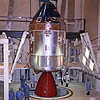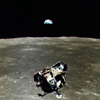
|
Following their historic landing and exploration of the lunar surface, Neil Armstrong and Buzz Aldrin rejoined Michael Collins aboard the Command Module. Collins, as Command Module Pilot, fired the Service Module’s large engine and headed back to Earth. Several days later, on July 24, they discarded the Service Module and entered Earth's atmosphere. To protect the crew and the priceless cargo, Columbia's exterior was covered with a phenolic epoxy resin ablative heatshield. As it entered the atmosphere at a speed of 40,000 kilometers per hour (25,000 miles per hour), its exterior reached a temperature of 2,760º C (5,000º F) burning off most of the reflecting film cover. The heatshield protected the craft from burning and vaporizing. Columbia finished its flight with a parachute landing in the Pacific Ocean. The remainder of the kapton film was removed after the flight. |
|
1 Command and Service Module "Columbia" during assembly. 66k jpg NASA History Office #69-HC-439 2 Apollo Lunar Module ascent stage approaches Command and Service Module "Columbia" in lunar orbit. 29k jpg NASA #AS11-44-6642 |
|

